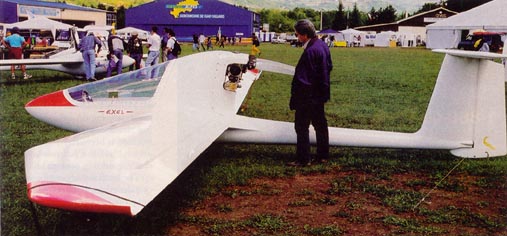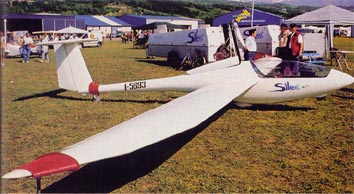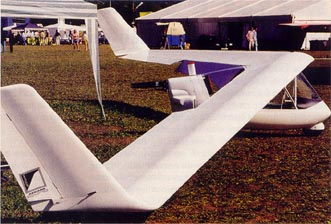
A third-generation design from Noins Aeronautiques Alpaero, Exel is a sleek ultralight motorglider with a 45-foot cantilever wingspan.

A tiny single-cylinder engine has little exposure to the air, and Exel’s fully folding prop further reduces drag.

Designed by Max Barel, the Graal is a multi-composite of molded wood and carbon fiber. It was successfully test-flown on January 4, 2004.

Some Americans have seen the Silent at airshows. Lucky them. This beautiful italian work of art is every bit as slick as a $150,000 motorglider, but it sells for only $32,000.

One reason for a one blade prop is that it fits into the Silent’s compace interior.

Pilots will find plenty of goodies in the Motor Swift. Phone, GPS, radio and variometer/altimiter/barograph line the eyebrow level. Handles or levers control flaps, trip, throttle, joy-stick and the rocket parachute.

The flying-wing Motor Swift is a California design built in the U.S. for some years before Belgium-based Aeriane bought the rights to manufacture it for the European market.
The ultralight motorglider evolution continues in Europe.
Ultralight motorgliders are as rare as hen’s teeth in the U.S., but Europe is blessed with several choices that nicely complement high-end, high-priced full-size motorgliders. While America has the lovely Esprit from Aero Dovron, our soaring friends across the Atlantic continue to lead this specialized market.
Full-size (higher-weight) motorgliders start at more than $100,000 and can surpass $200,000. Those who can afford them are surely thrilled with such beautiful machines, but most of us can’t spend that kind of money regardless of their superb performance.
However, at $20-$30,000 ready-to-fly, a clean self-launching soaring aircraft is more affordable. Like their larger siblings, these efficient designs can also cruise under power respectably well, giving them broader appeal than pure gliders.
Noins’ Excel
One of the newest of the breed is the Excel from France’s Noins Aeronautiques Alpaero. Based in beautiful Tallard in the French Alps, Noins is revered by French soaring pilots.
The Excel was so well received that delivery times initially jumped to one year. Noins also produces the Choucas model, a two-seat trainer, and the company formerly made the Sirius, a single-place. The newer Excel returns to a lighter, somewhat simpler design but reveals its ancestry by incorporating the best features of the earlier models.
With a wingspan of 45 feet, this is a serious soaring machine, boasting a glide ratio of 30:1 and a sink rate of 150 fpm. These two measurements are important for any soaring aircraft and the Excel’s results position it between hang gliders (at about 15:1) and full-size sailplanes that can achieve 60:1 glides.
The Excel is designed for a single-cylinder engine equipped with a folding prop that streamlines itself automatically when the engine is shut down for soaring flight. The engine is mostly faired by the fuselage aft of the pilot, so it doesn’t involve retract complexity.
Excel sells for $32,000 in ready-to-fly form and is available as a kit for $22,000, excluding shipping. American pilots could operate it with an FAA motorglider rating, which does not require a medical. (This aspect is common to all motorgliders.) The Excel is also the heaviest of the ultralight motorgliders in this column with a 418-pound empty weight.
The Graal
Max Barel seems as much artist as motorglider designer. His artistic Graal, made of an exotic combination of molded wood and carbon fiber, looks like nothing else I’ve seen.
Coupled with its distinctive construction, the Graal features a propeller situated aft of the tailplane. Like the Excel, the Graal’s propeller folds to streamline when powered down for soaring flight. A tailwheel is streamlined in the bottom of an extended rudder.
The Graal’s engine is mounted permanently inside the fuselage. Once the engine has been shut down for soaring flight and has time to cool, a door over the exhaust port can be closed for maximum aerodynamic cleanliness.
With a claimed 40:1 glide ratio, the Graal is the performance leader of our four subject aircraft. The design also achieves a sink rate of only 160 fpm. Though it’s the second heaviest of our four models at just under 400 pounds, it is easily carried by its 49-foot wingspan.
Priced at about $25,000 ready to fly, the Graal competes well in this aviation segment. Shipping and crating add to the delivered cost.
Alisport’s Silent
Of all the ultralight motorgliders reviewed here, the Silent is perhaps the best known because Italian producer Alisport has brought its elegant creation to shows such as Sun ‘n Fun and AirVenture Oshkosh.
When I first saw the Silent fly in a French airshow, I was amazed that the single-cylinder engine and its distinctive single-blade prop launched and ascended with such energy. Ground roll was surprisingly short, and climb was healthy. No doubt this is aided by Alisport’s efforts to keep the Silent light, at less than 300 pounds empty.
Alisport uses a counterbalanced single-blade prop for efficiency-a lone blade passes through air undisturbed by other blades-but the company has another motivation. With one non-folding blade, the small engine and prop can be neatly retracted into a small cavity in the fuselage. Larger motorgliders use a similar retract technique, but the bigger engines and two blades needed to lift such aircraft also require a larger space for retraction.
With the engine and prop retracted and the cavity door closed, the Silent looks much like a sailplane. Naturally, this yields benefits for soaring efficiency while also preserving a familiar appearance.
The Silent’s 40-foot wingspan can achieve a glide ratio of 32:1 and a sink rate of 140 fpm, according to factory information. It is priced reasonably at $32,000 before shipping expenses.
Aeriane Motor Swift
Although the Swift is the most unorthodox design of our four subject aircraft, it has won converts among the large European soaring community.
With a glide ratio of 27:1 and a sink rate of 140 fpm, the Motor Swift is quite competitive, and it is unique for its tailless design. This 253-pound plane, the lightest of our four subject motorgliders, has been flying for a decade without problems.
Though the Swift is popular in Europe, it began life as an American design from U.S. producer Brightstar. The San Francisco-area company created the unpowered Swift in the early 1990s. Soon after its introduction, Brightstar offered the Motor Swift, but the company didn’t go nearly as far with it as Belgium-based producer Aeriane, which bought the manufacturing rights.
The European company finished the cockpit area and has fully enclosed it and the aft engine. These streamlining efforts have boosted glide performance by several points.
The Motor Swift comes with easily removed wings for simple transport and storage and is sold ready to fly with starter, folding prop, and instruments for about $25,000.
Note: This article does not comment on how each of the subject aircraft fit into American regulations. The Motor Swift can qualify as a Part 103 ultralight. The Excel, the Graal, and the Silent will require amateur-built approval, but most would qualify under Sport Pilot if that rule passes into law. All but the Motor Swift are available as kits, according to factory reps, but their qualification under U.S. rules has not yet been determined. KP


I would spend the money on a motor glider any day. I need a contact person. I am trying to find some body to email and call, I would need lessons. I live in San Diego.